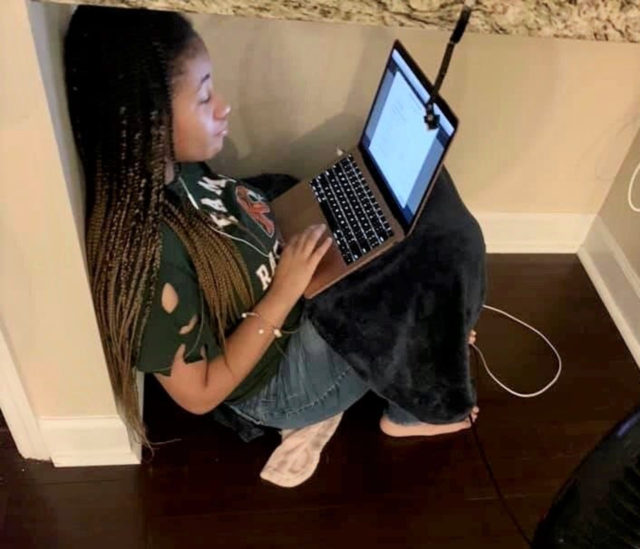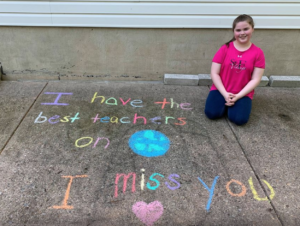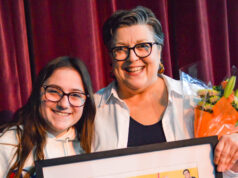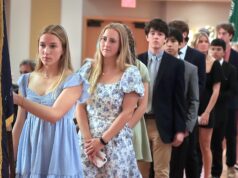
Nearly eight weeks after schools in the Diocese of Wilmington were closed because of the coronavirus pandemic, distance learning has become the norm. What once was a novelty is now routine, and although the potential for fatigue on everyone’s part is there, teachers believe students are still putting forth their best effort and getting results.
At St. Elizabeth School, the transition was fairly smooth, according to Kammas Kersch, a technology coach and science teacher in the upper school. In April, Kersch wrote in her blog, Tales of a Techy Teacher, that she anticipated a shutdown in early March and went to work to make sure the school’s teachers were ready to go. In an interview this week, she said she is not surprised how well St. Elizabeth has done in the virtual classroom.

“I think we were very confident from the beginning that we spent years putting the time and energy into our one-to-one learning environment with the iPads, and I think it paid off when this all happened,” she said.
Students and staff were equipped with the tools needed to work from home, and many of the teachers were already using them in their classrooms. The only addition was the ability to do video calls. St. Elizabeth students did not miss a day of instruction.
Will Simpson, an economics and world history teacher at Saint Mark’s High School, has found his students – freshmen and seniors – “are more involved than they usually are in an ordinary year.
“I have not had to ask more than 2 or 3 percent of my students where their work is. And the stuff they’re turning in is good quality, especially my freshmen. They’ve been very, very adaptable,” he said.
His colleague at Saint Mark’s, Danielle Smith, said she and her students had some adjusting to do since she teaches health and physical education. They can’t do the exercises or activities they usually do, so she has gotten creative. She has her students do workouts from YouTube videos, and she had them create Tik Tok videos of them doing a fun workout, which helps morale.
Smith said the kids have held up well, although several have mentioned to her they’d prefer to be back in the school building.
“Definitely the seniors are the most upset with this for obvious reasons. The freshmen, they’ve been doing, by far in my opinion, the best with it,” she said.
She tried meeting with them through Zoom, the popular video-conferencing software, but she said she didn’t believe she was getting across to them as well as she normally does. Instead, Smith prefers a messaging system available through Saint Mark’s website.
Adjustments were necessary
Ursuline Academy was on break the first week schools were closed, so that gave its teachers time to prepare for the unprecedented situation. At that point, they knew they’d be out for at least an additional week after the break ended, so students took some work home. As it became apparent that the shutdown would last significantly longer, Ursuline surveyed parents about available technology in the home and other factors that could impact their children’s education. That really helped, fourth- and fifth-grade teacher Melanie Aube said.
“It was a little stressful in the beginning to make sure we were doing everything the right way, keeping the safety of the children in the front of our minds,” she said. “But once we got the hang of everything, and with the help of our technology department, we seem to be handling locking our meetings, password-protecting everything, sending new links out daily to the kids. Everybody’s sort of into a routine by now, so it’s working well.”
Aube said she is impressed with how the students have handled being at home for this long. As Easter passed and it became apparent that at-home schooling would be in place for the balance of the academic year, the students have stepped up.
“They really have risen to the occasion. They all attend class everyday. I rarely miss someone. They’re taking it seriously,” she said.
Aube described her work as a bit more intense than normal. During her video classes, she has to keep her eyes on so much. She tries to detect concern in their voices and changes in facial expressions.
“When you’re watching everybody’s little faces on the screen all at once, you have to be into every little thing that’s happening. That’s an interesting learning experience,” she said.
Kersch said one of the challenges of the virtual classroom is the inability to control the environment, such as room temperature, but teachers are doing a great job creating a community. Kersch said she is attuned to more than just her curriculum.
She is working now with the understanding “that students have sick family members. Students have, at the same time they’re trying to do their schoolwork, siblings who are trying to do their schoolwork.”
It’s understood if students or faculty get frustrated at times.
“Everybody is working under different circumstances right now, and we need to be sensitive to that. I think our students are resilient. Our staff is resilient. I have been impressed with everyone choosing to have a positive attitude as much as they can, but also understanding that it’s OK to not be OK,” Kersch said.
It’s a perspective Aube sees from both sides. Not only is she a teacher, but she is the parent of an Ursuline senior, Mia, and fifth-grader, Brennan. She said her daughter is hanging in as well as can be expected.
“She’s still engaged, more so than I expected at this point,” Aube said, adding that the school deserves credit for the way they’ve handled virtual learning. “I think they’re doing it with a lot of compassion and understanding knowing that this is not the ideal way for a senior to end her high school years.”
Possible classroom changes
The teachers said they will find ways to incorporate some of what they have learned during the distance learning into their traditional classrooms. Simpson said he will re-work his lesson plans over the summer to improve his courses.
For example, one of his classes is currently studying the Renaissance. Normally, he’d have his students make trading cards of famous figures.
“This year, I had them do movies, and the movies blew my mind. They did such a good job creating movies about a Renaissance architect, writer and artists that I’m not going back to the old way of doing things any more,” he said.
Simpson also had students create tests for some subjects, and “the questions they came up with are much more rigorous than I would have come up with myself. They are learning. The knowledge that they are learning is sticking.”
The collaboration between teachers and tech companies has impressed Simpson, and the University of Delaware has been a great resource. Some of these partnerships might never have happened with traditional professional development, he said.
Smith said she has found courses online that she will use with her health classes at Saint Mark’s. A current lesson is about drugs, and some video resources use real-life experiences as opposed to lectures. Quizzes can be done online.
“That’s definitely something that I would like to incorporate somewhat into the actual classroom. Maybe I’ll show the videos of the real-life examples opposed to lecturing about what we read in the book because that would bring home the point a little more clearly,” she said.
As much as she loves technology, Kersch said she misses the in-person aspect of the St. Elizabeth community. And she never expected this.
“I never once in my career thought I was going to teach almost a full quarter virtually. No one trains you for that when you go to college,” she said.







